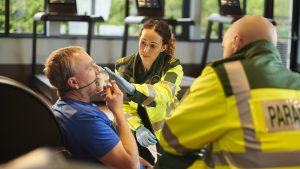
Dr Charmaine Griffiths, Chief Executive of the British Heart Foundation discusses the vital steps that need to be taken to ensure cardiac care can suitably meet the needs of heart patients in the UK.
Over two years on from the start of the COVID-19 pandemic and its impact on heart patients remains striking. Waiting lists for cardiac care in England have climbed to over 337,000 people, a rise of 45% since February 2020. Not only are there more people waiting, but they are waiting longer. At the end of July, there were more than 6,800 people in England waiting over a year for a heart test or treatment, compared to just 28 in February 2020. Such long waits can have tragic consequences. The longer the delay to vital cardiac treatment, the higher the risk of preventable heart attacks, disabling heart failure, or even premature death.
The immense pressure on elective care can be seen across the health service in England (NHS). Average ambulance response times for suspected heart attacks and strokes are over 40 minutes when the target is 18 minutes. At the same time, blood pressure management in primary care has been devastated. The system is in crisis, despite the heroic efforts of NHS staff who have worked every hour of the day in the most testing of circumstances.
But we cannot blame the pandemic for all of these problems. Before 2020, waiting lists for vital cardiac care were already too high, and despite best efforts, ambulance services in England had never met the target of an average ambulance response time of 18 minutes to reach suspected heart attack or stroke patients since reporting began in 2017.
The recovery of cardiac care services
The recovery of cardiac care services to pre-pandemic levels is not enough to build a future free from the fear of heart and circulatory disease. We must do better, go faster, and strive for more. As the new government sets out its priorities in health, we need to recommit to national cardiovascular disease (CVD) aspirations, while also identifying priority areas for particular attention and acceleration. Prioritising will not be easy as the pandemic has disrupted progress against all CVD metrics in the NHS Long Term Plan, and BHF analysis shows that most of the headline CVD commitments from the plan will not be met on time.
Investment in science and innovation alongside collaboration with global partners got the UK through COVID-19, and it is a commitment to continue to invest and collaborate that will get us closer to a world free from the fear of heart and circulatory diseases. Horizon Europe is the world’s largest research and innovation programme, and the UK’s association with Horizon is highly beneficial for UK and EU researchers. From 2014-2020, UK researchers received €7 billion – 12% of all awarded funds, second only to Germany – as well as unparalleled collaborative opportunities through prestigious grants from organisations such as the European Research Council (ERC).
Concerningly, ongoing disputes over trade with Northern Ireland mean that negotiations around the UK’s association with Horizon have been jeopardised. These delays are sparking ‘brain drain’ fears, with some leading UK researchers already relocating to retain their Horizon funding. Clinical research is the backbone of healthcare, and our Prime Minister must prioritise research and development so that recovery from COVID-19 can continue.
To ensure patients continue to benefit from new treatments, techniques, and teachings we need to make research a routine part of healthcare in the UK. The Health and Care Act formally places a duty on the Secretary of State, NHS England, and Integrated Care Boards to facilitate research. This is an excellent starting point, but to take full advantage of it we need a supported and skilled research delivery workforce, providing dedicated research time for NHS staff and promoting clinical academic careers would go some way to achieving this.
Diversity is needed in clinical trials and research
We also need to encourage more diversity among clinical trial participants. It is well documented that despite CVD being a leading cause of death among women, female participants have been consistently underrepresented in cardiovascular clinical trials. Failing to include certain groups such as women in research limits the generalisability of that research and, at worse, can have adverse healthcare consequences for that excluded group.
The pandemic not only produced exceptional examples of innovations in the way we do research but also in the delivery of care. But we cannot rely on these innovations alone to address rising NHS pressures and tackle the enormous backlog of time-sensitive cardiac care unless we have the right number of dedicated, trained, and supported health workers. To ensure every cardiac care patient gets the care they need when they need it, the UK Government must match the bold CVD ambitions outlined in the NHS Long Term Plan with the necessary investment and cardiac workforce.
Heart and circulatory diseases still kill one in four people in the UK, adding to the burden on the health system and contributing to widening health inequalities. To tackle this, there must also be a renewed focus on preventing the risk factors that increase someone’s risk of developing CVD, such as obesity, smoking, and having an unhealthy diet. We need to see bold action on population health, with an interventionist approach aimed at making population-level change, rather than policy measures that rely on personal risk reduction. This government must make disease prevention a priority if they are to see an increase in healthy life expectancy. This includes not rowing back on bold policies that address our obesity crisis – namely those outlined in the 2020 Obesity Strategy, and the Soft Drinks Industry Levy implemented in 2018 – and publishing the next Tobacco Control Plan which details how to reach a Smokefree England by 2030.

Ambulance services in England had never met the target of an average ambulance response time of 18 minutes to reach suspected heart attack or stroke patients since reporting began in 2017
Improving survival chances of cardiac arrest
Finally, we must not forget about the 30,000 out-of-hospital cardiac arrests each year in the UK. Devastatingly, the survival rate is currently less than one in 10. But we know that the chance of survival from a cardiac arrest doubles in some cases if someone receives CPR, and that using a defibrillator can also significantly increase someone’s chance of surviving.
That is why we have developed The Circuit – a national defibrillator network, to ensure that anyone who suffers an out-of-hospital cardiac arrest has the best possible chance of survival while they wait for emergency cardiac care. The Circuit already has over 50,000 defibrillators registered, more than a third of which ambulance services were not previously aware of. We now need to ensure all defibs are visible to emergency services and that we address gaps in provision.
But critically, we must also equip the public with the knowledge and confidence to intervene in what is the ultimate medical emergency. Building on commitments to introduce CPR to the curriculum, and install a defibrillator in every school in England, we must ensure lifesaving CPR training is free, easy and accessible. The BHF’s new interactive CPR training course – RevivR – should help with this. By taking these steps, we can begin to improve the odds of survival for countless people who have a cardiac arrest.

Horizon Europe is the world’s largest research and innovation programme, and the UK ’s association with Horizon is highly beneficial for UK and EU researchers.
The pandemic brought with it many challenges for heart patients, but it also taught us the value of resolve and unity. We need to harness the lessons of the pandemic to reach beyond recovery and work together to save countless lives from heart disease for generations to come.
Dr Charmaine Griffiths
Chief Executive
British Heart Foundation
http://www.bhf.org.uk
https://www.linkedin.com/company/british-heart-foundation
https://www.facebook.com/bhf
https://twitter.com/TheBHF
https://www.instagram.com/the_bhf/
This article is from issue 23 of Health Europa Quarterly. Click here to get your free subscription today.









